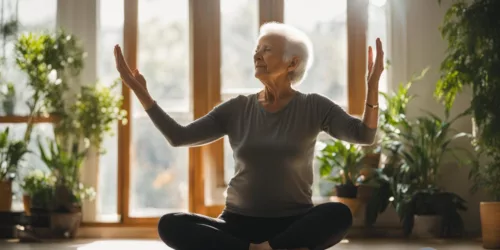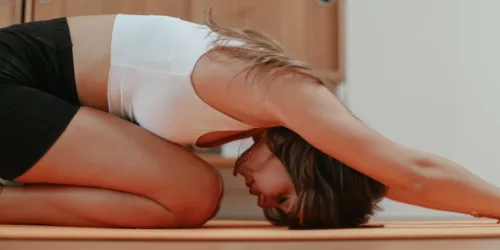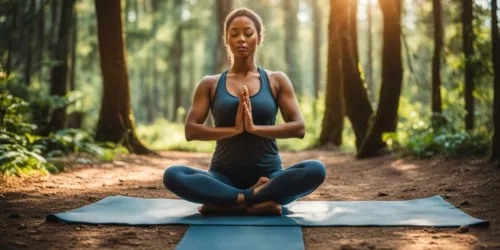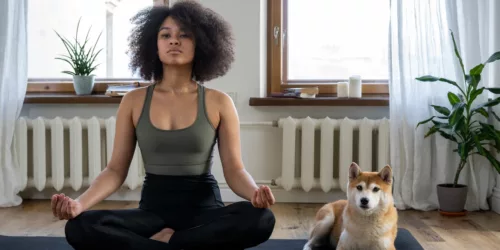The Evolution of Yoga Apparel: A Historical Perspective
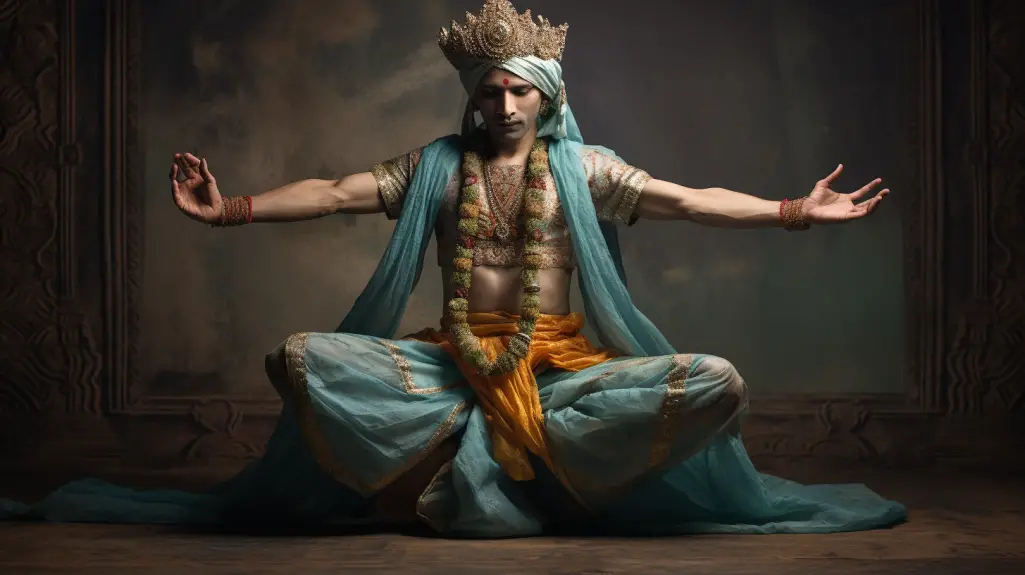
Have you ever wondered how yoga apparel has evolved over time?
This article will explore the historical journey of yoga apparel, from its ancient origins to its current global popularity.
We’ll look at traditional styles in India, the westernization of yoga wear, consumer trends, and the environmental impact of this rapidly expanding industry.
Join us as we uncover the fascinating past and present of yoga apparel.
Key Takeaways
- Yoga apparel has a rich history dating back centuries, with ancient yogis wearing loose garments made from natural materials like cotton, silk, and hemp.
- The westernization of yoga apparel has led to the blending of traditional Indian culture with modern fashion trends, resulting in fashion-forward designs that still prioritize comfort and minimal attire.
- The growing popularity of yoga has led to the rapid expansion of the yoga apparel market, with a wide variety of clothes and accessories catering to yogis’ needs and offering options for self-expression through clothing.
- There is a growing awareness of the environmental impact of yoga apparel, and the importance of promoting ethical practices and sustainability by choosing sustainable materials, eco-friendly treatments, and supporting companies prioritizing ethical production and sustainability initiatives.
Ancient Origins of Yoga Apparel
You may be surprised to learn that the origins of yoga apparel date back centuries!
Yoga has been practiced for over 5,000 years and its traditional clothing was designed with comfort in mind.
Ancient yogis wore loose garments made from natural materials such as cotton, silk, and hemp. These eco-friendly fabrics provided breathability and freedom of movement during practice.
The production of these garments also followed ethical standards, meaning that they were produced with respect for animals and the environment.
Today, modern yoga apparel still follows many of these ancient principles, although it has become more stylish and colorful to meet the needs of a contemporary audience.
Traditional Apparel in India
Your traditional Indian apparel has been around for centuries. The textile industry in India is an ancient one and rural production of clothing items has been a primary source of income for many families.
Traditional items such as saris, kurtas, salwar kameez, and dhotis are made from natural fibers like cotton or silk and designed to provide comfort while practicing yoga postures. These garments are lightweight and often feature hand-stitched details that reflect local cultural values.
Colors can range from the bright hues found in the fabrics used by Rajputs to simple whites worn by yogis looking to achieve spiritual enlightenment. Westernization of yoga apparel has become increasingly popular over the years, but traditional Indian clothing remains an important part of the practice’s history and culture.
Westernization of Yoga Apparel
In recent years, the westernization of yoga apparel has had an impact on both cultural influences and market expansion.
As a result, there has been an influx of fashion-forward designs that draw from both traditional Indian culture as well as modern styles.
These new trends have opened up the yoga apparel market to a much wider audience, allowing for increased access to products and greater recognition of Indian culture globally.
Cultural Influences
Throughout history, cultural influences have shaped the evolution of yoga apparel. Traditional yogic philosophy supports the idea that one should wear comfortable, minimal attire to help facilitate focus and breathwork. This often meant wearing lightweight clothing made from sustainable materials such as cotton or hemp.
In addition, many practitioners adopted looser-fitting garments with a non-restrictive fit for added mobility and comfort during activities. As more people began to practice yoga in the West, designs were adapted to reflect modern fashion trends while still keeping true to traditional values.
This combination of fashion and function has allowed yoga apparel to become an integral part of Western cultures while staying rooted in its Eastern origins.
Market Expansion
As yoga becomes increasingly popular, the market for yoga apparel has exploded, giving you more options than ever to dress comfortably and stylishly.
From traditional clothing such as leggings and tank tops to more fashion-forward pieces like jumpsuits and bodysuits, there is something for every yogi’s style.
The increased demand for yoga clothes has also led to a greater emphasis on sustainability with many brands now producing eco-friendly materials in order to reduce their environmental impact.
Furthermore, the fashionability of yoga apparel has skyrocketed over the years with high-end designers taking inspiration from classic yogic silhouettes in order to create unique pieces that stand out in any crowd.
With all these changes, it’s clear that the evolution of yoga apparel continues at an exciting pace as consumers are offered a wide range of options when it comes to expressing themselves through their clothing.
Rapid Expansion of Yoga Apparel
With the growing popularity of yoga in recent years, the demand for specialized yoga apparel has skyrocketed. Manufacturers have responded to this increased demand by offering a wide variety of clothes and accessories that cater to yogis’ needs. The range of products offered ranges from high-end designer clothing to basic cotton items that are designed specifically for practicing yoga.
The rapid growth in the industry has seen an influx of companies who specialize in producing sustainable and ethical apparel options. Additionally, businesses have begun to focus on creating fashion-forward designs while still maintaining comfort and functionality. As a result, customers now have access to a wide selection of stylish yet functional pieces that are adapted specifically for yoga practice.
1) Yoga’s Impact: It’s estimated that almost 20 million Americans practice yoga regularly with numbers continuing to rise every year.
2) Sustainable Practices: Many manufacturers are now focusing on sustainable practices such as using recycled materials or organic fabrics.
3) Fashion-forward Designs: Companies strive to create fashionable pieces while still providing comfort and functionality for yogis.
Consumer Trends in Yoga Apparel
I’m interested in exploring consumer trends in yoga apparel, including market demand and style preferences.
To better understand these trends, it’s important to consider demographic data such as age or gender. These factors can greatly influence how people dress for yoga classes. Additionally, lifestyle habits play a significant role in determining what people wear to practice.
The overall fashion industry’s influence on yoga apparel should also be taken into account. Fashion trends and popular styles can greatly impact consumer preferences in this niche market.
In analyzing consumer trends, factors like pricing and availability of specific styles of clothes are essential. These considerations help us understand how consumers make purchasing decisions and what influences their choices.
Overall, by examining these various aspects, we can gain a comprehensive understanding of consumer trends in yoga apparel.
Market Demand
You’ve likely noticed the increasing demand for yoga apparel over recent years. From the rise of athleisure to an increase in health and wellness trends, more people are investing in quality clothing designed specifically for their yoga practice. Companies have responded by implementing innovative branding strategies that appeal to a wider demographic, as well as using sustainable materials to meet consumer needs.
Here are three key factors driving market demand:
- Comfort – People want clothing that allows them to move freely during yoga poses and stretches without feeling restricted.
- Aesthetic – Yoga apparel must be fashionable and stylish while still meeting comfort requirements.
- Functionality – Consumers seek clothing with features such as sweat-wicking fabric or integrated pockets for storing items securely during class.
In short, it’s clear that consumers have high expectations when it comes to purchasing yoga apparel, which has driven companies to develop new products and design features that meet changing demands.
Style Preferences
Trends in yoga apparel have seen a dramatic shift over the years, with more consumers favoring styles that offer comfort and functionality alongside aesthetic appeal. The athleisure trend has had a major hand in this, driving an increased demand for modern materials such as spandex, polyester and nylon blends. Comfort is key when it comes to yoga apparel, with items such as leggings becoming commonplace for practice or leisure.
| Style | Characteristics |
|---|---|
| Athleisure | Combines comfort and style while using fabric technology to create garments that move with your body |
| Traditional Yoga | Loose fitting clothing made from lightweight cotton fabrics allowing freedom of movement without restriction |
| Yogawear/Activewear | Designed to be form-fitting but still comfortable; often feature high tech materials such as moisture wicking fabric and 4-way stretch fabrics for maximum performance |
Environmental Impact of Yoga Apparel
You’re likely aware of the environmental impact that yoga apparel can have, especially when it’s produced by unsustainable methods. It is essential to promote ethical practices and sustainability in the production of this type of clothing.
Here are 3 ways to reduce the ecological footprint:
- Choose sustainable materials such as organic cotton, bamboo, hemp or Tencel-Lyocell.
- Embrace eco-friendly treatments like vegetable dyes versus synthetic chemicals.
- Support companies who prioritize ethical production and sustainability initiatives.
Ultimately, being mindful of our purchases and their impact on the environment is key for creating a better future for all living beings.
Frequently Asked Questions
What Are the Best Yoga Apparel Brands?
I’m looking for the best yoga apparel brands that are eco friendly and fashion forward. Many popular brands offer stylish and comfortable clothing made from sustainable materials, such as Lululemon, Athleta, Prana, and Organic Cotton Plus.
What Is the Average Price Range for Yoga Apparel?
When shopping for yoga apparel, price comparison and buying advice are key. Prices can vary greatly, but generally range from $20-$100 per item. It’s important to compare prices to get the best deal.
Are There Any Ethical Considerations When Buying Yoga Apparel?
I’m considering ethical considerations when buying yoga apparel, such as sustainable production and ethical sourcing. It’s important to ensure that the companies are following eco-friendly practices while producing quality clothing for yogis.
What Is the Current Global Market Size for Yoga Apparel?
The global yoga apparel market is estimated to be worth around $108 billion and growing, featuring sustainable materials and innovative designs. It continues to expand as more people adopt a healthy lifestyle.
What Are the Most Popular Styles of Yoga Apparel?
“As the saying goes, ‘the times they are a-changing’, and this is true for yoga apparel styles too. Popular trends range from traditional to modern, with cultural influences from around the world. Today’s yogis can choose from an array of fabrics and silhouettes, each designed to make comfort a priority. There’s something for everyone in the ever-evolving world of yoga apparel.”
Conclusion
As I reflect on the evolution of yoga apparel, it’s clear that the journey has been one of constant change.
From its traditional roots in India to its modern forms, it has become a symbol of wellness and self-care for many around the world.
With advances in technology, eco-friendly materials, and consumer trends come opportunities to create clothing that is stylish and sustainable.
As we look towards the future, let us remember to stay mindful of our impact on the environment and invest in pieces that will last for years to come.

